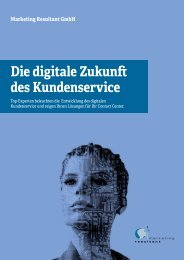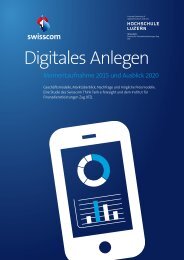Technology
tax14-technology-abo-version-lowres-151020
tax14-technology-abo-version-lowres-151020
You also want an ePaper? Increase the reach of your titles
YUMPU automatically turns print PDFs into web optimized ePapers that Google loves.
<strong>Technology</strong><br />
1950s 1995 2005 2010 Today<br />
Period of historical change for the technology stack<br />
<strong>Technology</strong> eras and<br />
interfaces of change<br />
Mainframe<br />
computing<br />
Minicomputer<br />
Client-server<br />
internet<br />
Virtualized<br />
data centers<br />
Cloud solutions<br />
Velocity of change Multiple decades About 15 years About 10 years Less than 5 years Quarters and months<br />
Technological<br />
catalyst<br />
Hybrid circuits Integrated circuits Microprocessor;<br />
network and<br />
productivity software<br />
Hypervisor and<br />
cost-efficient<br />
server chips<br />
Mobility, cloud computing<br />
and big data<br />
Impact on<br />
the technology<br />
stack<br />
Birth of hardware,<br />
software and services<br />
paradigm<br />
Beginnings<br />
of distributed<br />
architecture; smaller,<br />
more accessible<br />
Expansion of<br />
distributed architecture<br />
and requirements<br />
Conscious decoupling<br />
with moderate benefits<br />
Convergence, disruption<br />
and new paradigm<br />
Estimate of global<br />
value of technology<br />
Much less than<br />
US$100 billion<br />
Over US$100 billion Over US$1.5 trillion Over US$2 trillion Over US$3.5 trillion<br />
<strong>Technology</strong> incumbents<br />
(S&P 500)<br />
Under 10 About 40 About 80 About 80 About 70<br />
Source: EY analysis<br />
• Reimagining business: Not long ago, a company that spent<br />
time and money to reimagine its business was thought of as<br />
forward-thinking. Now, C-suites and stakeholders see reimagining<br />
as a strategic necessity — from the way they interact with<br />
customers to their approaches to developing, marketing, pricing<br />
and distributing their products and services. Those that are<br />
slow to move forward are more likely to find themselves in the<br />
crosshairs of disruptive start-ups or shareholder activists who will<br />
force the issue.<br />
• The blurring of industries: This blur has the potential to<br />
make competitors of technology companies and incumbent<br />
players in every industry. A few sectors are clearly leading in this<br />
digital transformation, such as the media companies and others<br />
mentioned at the beginning of this article. But look for more<br />
of the traditional lines of definition to blur — across the board —<br />
and for new competition to proliferate. For example, health<br />
care companies are becoming technology companies and vice<br />
versa, while smart apparel could blur fitness and sports apparel<br />
companies together — and blur both with tech. Companies<br />
once contained in a distinct technology sector are breaking out<br />
into other industries as well. Tech companies recognize the<br />
need to market and deliver true solutions to customers’ issues —<br />
solutions that go beyond tech-centric building blocks and even<br />
entire technology stacks to address discrete issues and<br />
requirements industry by industry.<br />
Asking three big questions<br />
As dramatic and fundamental change claims an immutable spot<br />
on the corporate agenda, three core questions can focus<br />
executives on considerations for their own digital transformation:<br />
• Have you challenged the inefficiencies in your company?<br />
“Inefficient distribution and idle capacity can exist anywhere in a<br />
company and very often do,” Hyek says. <strong>Technology</strong> can help<br />
identify these gaps and show how to fill them. Disruptive start-ups<br />
and sharing-economy business models are using technology<br />
to connect more directly to customers — what they want, when<br />
they want it and what they’re willing to pay. The 21st-century<br />
iteration of ride-sharing and home-sharing are prime examples of<br />
how new models can change customer behaviors, expectations<br />
and relationships while also enabling more efficient use of assets<br />
and capital.<br />
• How well do you know your nontraditional competitors?<br />
As the connection between company and customer becomes more<br />
direct, it isn’t enough for a company to understand its traditional<br />
industry-specific competitor. Says Hyek, “Companies need to look<br />
outside their same-sector roster — and especially to start-ups in<br />
this era of rising entrepreneurship — for insights that can help them<br />
reimagine their competitive environment.”<br />
• Are you agile enough to adapt to rapid change? This question<br />
applies to the culture of a company as well as to its operating<br />
model. Digital technology opens up new opportunities such as<br />
crowd-sourcing, for example, and even calls into question<br />
how a company’s own R&D department might stack up against<br />
crowd-sourcing and big data. “You might ask, ‘How much<br />
of a marketing department or an R&D department do I need?’<br />
That kind of thinking can be transformative, if a company is willing<br />
to change and can respond quickly,” Hyek says.<br />
What it means for mergers and acquisitions<br />
“<strong>Technology</strong> and nontech companies alike are turning to tech<br />
mergers and acquisitions to keep up with the accelerating pace of<br />
change,” says Jeff Liu, EY Global <strong>Technology</strong> Industry Transaction<br />
Advisory Services Leader. Disruptive technology has given<br />
rise to a blockbuster era in deal-making, including an increase in<br />
the number of megadeals, according to the EY’s Global <strong>Technology</strong><br />
M&A Update, April—June 2015. These deals position tech buyers<br />
with end-to-end solutions to address the explosive growth in<br />
connected devices enabled by the “Internet of Things,” continued<br />
40 EY – Tax Insights for business leaders №14







